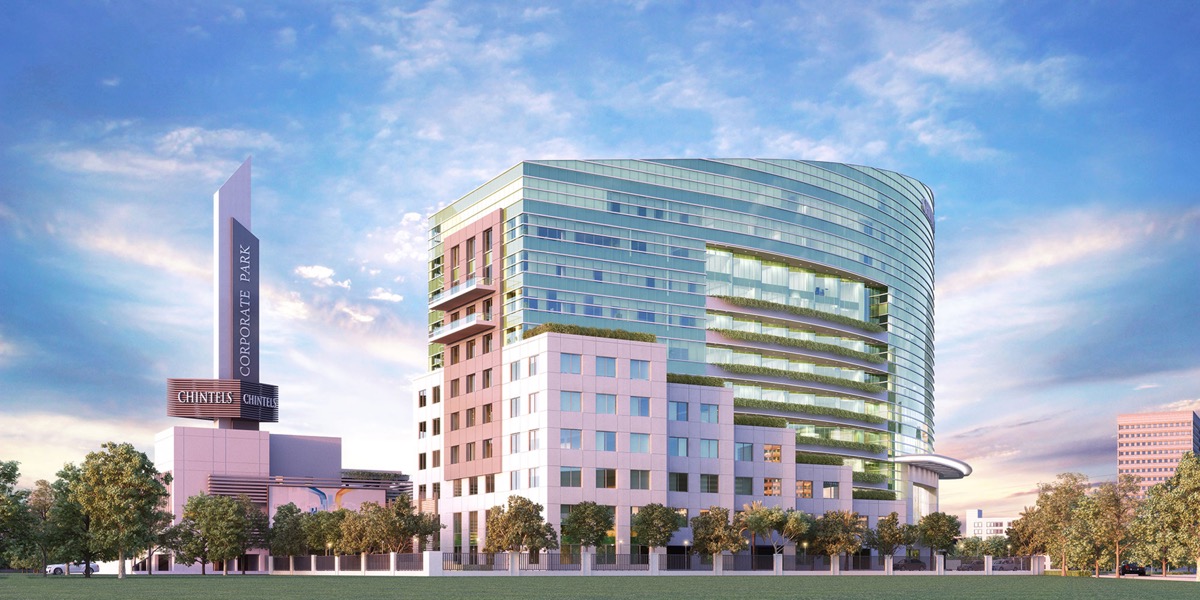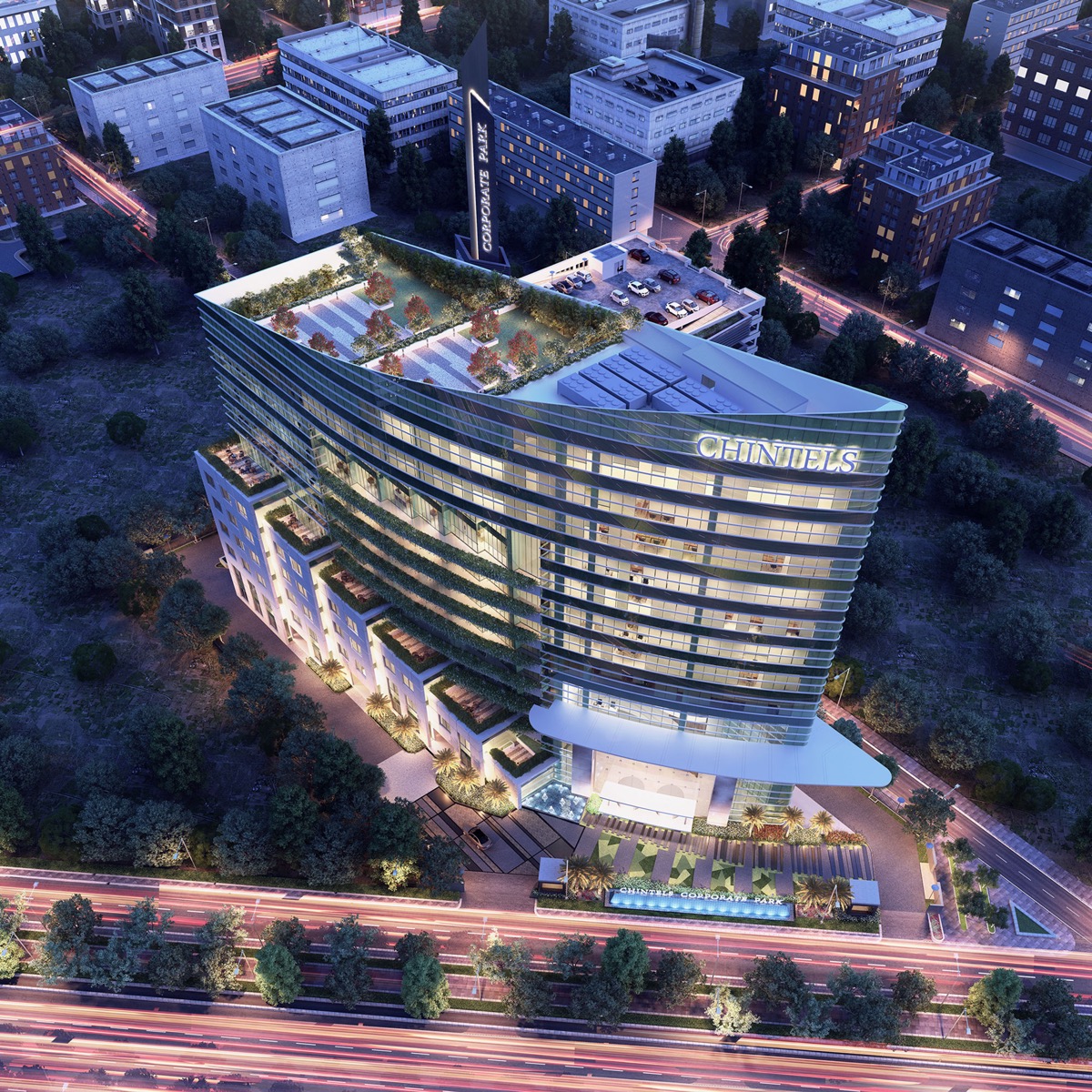
The Chintels Corporate Park is conceived as a boutique office complex where efficiency meets clean and contemporary aesthetics to create a landmark office building in the suburban commercial hub of Gurgaon. The project is visible along a flight descent and is designed to be iconic and distinctive through its form.As one moves down from Dwarka express line of the Delhi airport, the crown is witnessed along with the rhythmic stepping of the green terraces.

Anticipated as a green office building with a series of stepped terraces starting from the human scale at the ground floor roof up tothe 6th floor, the terraces at the 6th floor transform into large deck balconies until the 8th floor and eventually leading to become large terraced lawns that go upto the 12th floor; creating a sharp tall front corner that becomes the crown of this very elegant structure.
Designed with an intention of moving away from the typical office block morphology of closed box environments, these offices are planned with garden terraces, with little connection to the outside world, so that the people can experience the joy of outdoor spaces and use them as break-out spaces to refresh themselves. Despite the odd-shaped, trapezoidal site, the terraces and the built mass converge together as a singular composition, manifesting itself as an efficient workplace solution. The rectangular and triangular volumes at the front and the side are merged in a clean sweep, creating an illusion of a much larger building while diffusing the distinction between the front and the side.
The building has been planned as a stilt + 12 floors structure with a 4m clear height at every level and a flat slab structure to offer more height for services. Two interesting atriums have been planned; one for arrival and one for lounging and meetings both of which offer stupendous views of the triple height internal green walls and plush stone-finished lift lobbies. In order to create a skyline for this rather large mass and in keeping with the philosophy of a stepped volume, a design where the pointed tip became the highest point was explored. Thereby, despite the large size, the top of the building seems narrow, slim and sharp with the terraces stepping up along the side of the building. Long linear balconies have also been planned to offer open spaces, wherever terraces were not possible. The front set back of the building is designed as a vehicle-free zone, it serves as a refreshing landscaped entrance with waterscaping. An interesting pattern of stone and grass cleverly interwoven in a piano theme is one of the highlights of this picturesque landscape. A triple height atrium built into the front triangular corner of the buildingforms the grand entrance foyer, wherein the central reception and security are planned.

To welcome the visitors, a small cafeteria has been constructed in the corner.Post screening, the visitors would beoffered access cards and then have to cross security to access the main lift lobby which takes them to the respective floors. The top three floors have large terraces of 3000-4000 Sqft each, and are designed as resort offices that offer lavish working spaces. A food court is also planned on the 9th floor with a sit-out terrace, so that the occupants can enjoy the outdoor environment in good weather with a gym, fulfilling the modern day office requirements.
Due to a high water table, the building has only a single basement underneath, where the car parking is accommodated in the stilt and basement. A multilevel car park surrounded by the green planters at all levelsare placed adjacent to building. Since the building is long, two lift cores have been planned; one is near the arrival atrium and other is near the multi-level car parking. Designed as a LEEDGold-rated green building that uses glass intelligently, Chintels Corporate Park uses high-performance, double glazed units and appropriately designed shading devices. The surfaces on the south and west have been treated with smaller openings that are finished in dry cladding of Sand blasted Gwalior stone with recessed windows. The lift cores and the staircases are placed in the south west corner so as to minimize the office spaces in these directions that are exposed to the harsh sun. A Dual flushing system has been installed and a tertiary sewage treatment plants has been placed in the basement. Proper service lifts have been placed to ensure that material movement for fit-out work can carry on unhindered. The basement has been designed with skylights for adequate natural day lighting. All staircases have been planned on the external walls for natural day lighting, while Solar panels on the roof top generate sufficient light for the common areas.
The Facade cleaning system has also been planned very diligently with an inclined rail and staircase being planned along the outer periphery at the top to make the activity of façade- cleaning safe and convenient. The glass panels are carefully chosen to give a smooth curve and at the same time minimize the wastage on account of curved surface. The Signage of the tower sits prominently on the pointy top crown and because of its gently curved surface, it reads from the front as well as from sides, being seendistinctively from over a km away. Perceived as an iconic spot in the otherwise dotted skyline of Gurgaon workspaces, Chintels Corporate Park crafts a unique identity for itself as a green work-park in the sky!!
Project Facts:
Location : Sector 114, Gurgaon
Name of Client : Chintels India Ltd.
Principal Architect : Goonmeet Chauhan
Design Team : Ashish Jaiswal
Site Area (sq ft & sq m) : 3.2375 Acres
Built-Up Area (sq ft & sq m) : 3200 Sqmt
Project Status: Ongoing
Start Date : 01/07/2013



















